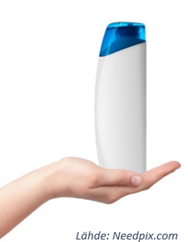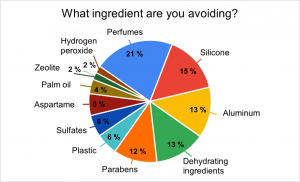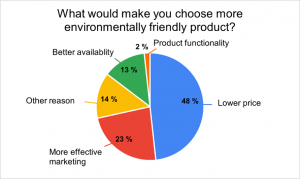Chemical awareness in families – case description from Turku UAS students

Turku UAS organizes each autumn a project hatchery (project work) for freshmen’s joining our campus. Each hatchery receives a task to work with and usually tasks are related to topical issues and they include a problem or problems which hatchery needs to solve. This autumn one project hatchery got an assignment from NonHazCity II project that challenged students to think how they could increase the awareness of families about hazardous chemicals. Students came up with an idea to organize information campaign based on a questionnaire that maps hazardous chemicals use in families. In this news text our students tell in their own words how they developed the campaign and which kind of results they received. Additionally, students describe what they learned from the task.
Text: Sini Räsänen, Tommi Ridanpää, Joni Sundqvist, Teemu Kananen, Justus Lindsten, Jesse Holberg, Maria Dominis Translated to English by Maria Dominis
We are a group of freshmen with varying majors at the Turku University of Applied Sciences. As part of our studies we have a course on project work, called Projektipaja. Each group was given their own project to finish during the fall semester. Our group was assigned NonHazCity as a mandator, who commission several hundreds of projects, one of which is the project given to us, NonHazCity2. The aim of the project is to empower professionals into improving risk management and to decrease the amount of harmful chemicals used in the cities the project runs in.
Our group’s project was to spread awareness on harmful chemicals to families through chemical inventory. We began to carry out our assignment by familiarizing ourselves with the project and the concept of chemical inventories. We decided the best way to fulfill our goal was by making a questionnaire aimed at families. With this questionnaire we intended to map out the habits of families when it comes to purchasing chemicals, and shared links with information on the chemicals mentioned. We also gave hints on how to make more environmentally aware purchasing decisions in daily cosmetics and gave DIY-hints on how to make their own. In two separate parts of the questionnaire we linked the application CosmEthics, which reads the barcode of a product and lets the user know whether the product contains dangerous chemicals, common allergens or certain ingredients the user wants to avoid.
To reach our target group we managed to attain two sponsors fitting to our project, who donated two gift cards we were able to use as an incentive to answer our questionnaire by holding a raffle between the respondents. We used the results of this questionnaire for analysis, on which this article is based on.
What we learned from the questionnaire
We made our questionnaire as short and concise as possible to encourage our respondents to finish the survey, but still comprehensive enough that we could get useful data out of it. We also decided that the questionnaire would focus on daily cosmetics that can be found in presumably all households. We received around 160 answers, with the majority of the respondents being in their early twenties, although we did receive answers from people that were 72. This is presumably due to the way the questionnaire was shared, and with the younger generations habits of further spreading information. The questionnaire was shared in several Facebook groups and on our personal walls, as well as through the application WhatsApp.
We inquired about the amount and ages of the potential children of the respondent between the ages of 0-20 in increments of 5 years, and noticed as we went through the answers that the ages of children trended high with over half of the children being 16-20. We suspect this is because of the relatively low age of most respondents, who likely don’t have children of their own yet, and the respondents with children tended to be middle-aged or older.
Most of the respondents made their own purchasing decisions, which seems to also be because of the respondents’ younger ages, and implies that the respondents live in their own apartments. Many people also preferred to make their own choices on whether their products contained perfumes, or what shampoo they would want to use.
We asked the respondents to pick one product they could find at their home and inspect its ingredient list. The suggested products were shampoo, hand soap, deodorant, toothpaste, and lotion. The grand majority went with shampoo (31%), hand soap (22%), or toothpaste (19%). We also inquired if the chosen product contained any of the following ingredients: resorcinol, triclosan, butylated hydroxytoluene, quarternium-15, or parabens. We chose these specific ingredients as they are commonly used in the cosmetics industry, and all have been noted to have some sort of harmful side effect. Only nine respondents reported that their product contained any of these, and out of those six reported that the ingredient was parabens. However, a significant number, 41 respondents so circa 25%, did answer that they were not aware whether their product contained any of the ingredients or not.
The question “What product do you avoid?” was left open which meant that respondents could write their own answers in the field given. This lead to some answers not being about daily cosmetics unlike how we had intended. Over a fifth (21%) said they avoided perfumes. These can cause rashes and respitory issues. The second most avoided ingredient was silicone, and while silicone isn’t necessarily harmful, it can in conditioners block the hair cuticles, causing the hair to appear flat and lifeless for especially people with curly hair. After that, respondents answered that they avoided aluminum and dehydrating ingredients (13% for both). Aluminum has been linked to breast cancer due to its common use in deodorants. Dehydrating ingredients mostly referred to alcohols, which are used often in cleansing cosmetics. 12% of the answers mentioned parabens, which can cause contact allergy. Other ingredients respondents avoided were plastics (6%), sulphates (6%), aspartame (6%), palm oil (4%), zeolite (2%) and hydrogen peroxide (2%).

All but one answered that they used all of the product, and half of them reported that they disposed of the packaging by throwing it in general waste. One respondent would reuse bottles with pumps and would purchase refills for it.
According to the questionnaire, a third of the respondents have considered the environmental friendliness of their purchases, but they were not convinced of the efficacy, price, or quality of the less harmful products. We also inquired what would convince the respondents to switch to more ecological products, and a large obstacle with these products was their pricing. Some of the suggestions from the respondents on what would convince them to swap to an environmentally friendly product were having them be ethically produced (Fair Trade Product), converting the products they already like and use into a more ecological form, and producing these products in Finland.

Reflections from the group
Most of the members of our group had not really considered their own carbon footprint. In the course of getting ourselves familiar with the assignment we learned together about different chemicals and the harms they could cause. For the majority the hazards that chemicals can cause to the enviroment and our own health was new information. Each member of the group learned new things, and has begun applying these in their own purchases.
The group project itself has also been a good learning experience. Our assignment was flexible, so we were able to give it our own flair. We learned valuable group assingment behaviors and skills, such as decision making and considering everyone’s opinions.
In conclusion
Our goal with the questionnaire was to receive 150 responses, so receiving around 160 in a week was a pleasant surprise. We also managed to reach specifically families with it, which was a part of our assignments goal. The responses on the questionnaire themselves also give a positive picture on how Finns think of harmful chemicals.
![]()
